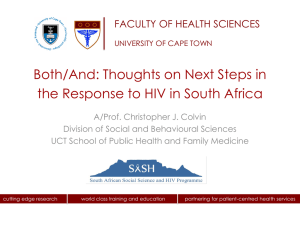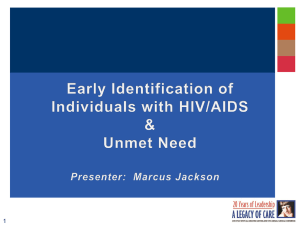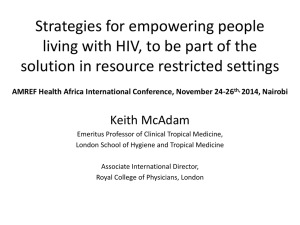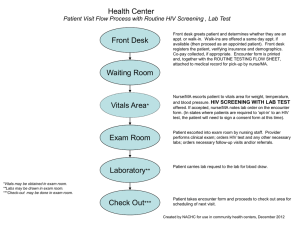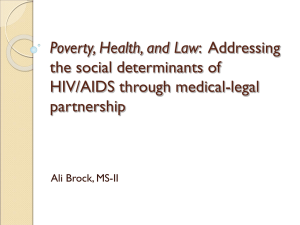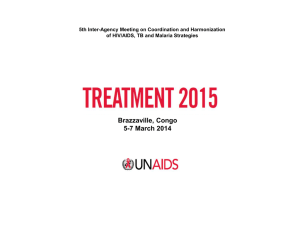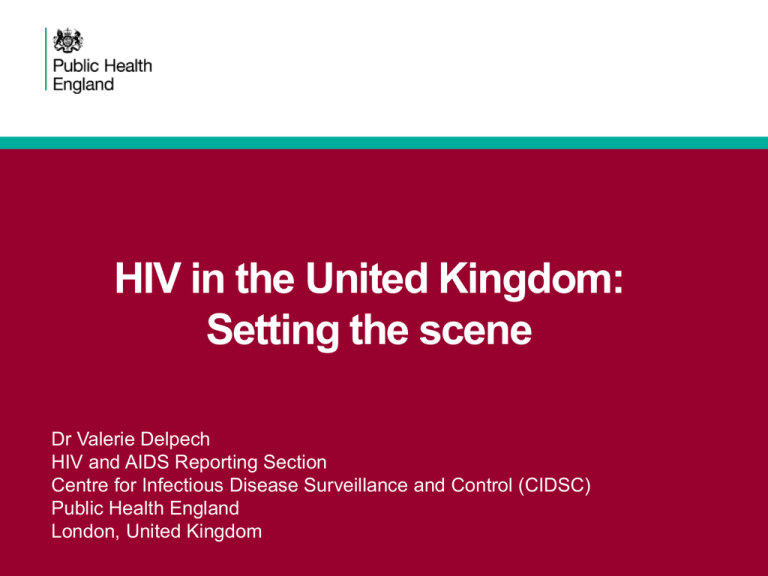
HIV in the United Kingdom:
Setting the scene
Dr Valerie Delpech
HIV and AIDS Reporting Section
Centre for Infectious Disease Surveillance and Control (CIDSC)
Public Health England
London, United Kingdom
HIV: the story in 2014
2
•
People living with HIV can expect a near normal life expectancy and very
good health outcomes if diagnosed in early stage of infection
•
As a result of 30 years of prevention efforts, HIV in the UK remains
relatively uncommon with an overall prevalence of 1.5 per 1,000 population
(1.0 in women and 2.1 in men).
•
An estimated 98,400 (93,500-104,300) people were living with HIV by the
end of 2012
•
Late diagnoses and high undiagnosed infections remain the biggest
challenge
•
Around 21,900 (22% [18%-27%]) of persons with HIV remain unaware of
their infection.
•
Of the 6360 persons diagnosed for the first time in 2012, 47% were
diagnosed late
Presentation title - edit in Header and Footer
HIV: the story in 2014 cont
3
•
No one should die of AIDS in the UK. Yet 390 persons died of AIDS in 2012
•
Despite cont. declines, death rates among persons with HIV are 3 X that of
general population
HIV in the United Kingdom: 2013
HIV: the story in 2014 cont
4
•
A total of 77,610 people (770 children and 76,840 adults) received HIV
care in 2012
•
1 in 4 adults living with diagnosed HIV are aged over 50 years.
•
97% linked to HIV care within 3 months of diagnosis with no differences by
age, gender, ethnicity, sexual orientation, sex and area of residence. (195
persons were NOT)
•
95% of the 76,840 diagnosed adults are retained in care annually (3,850
were NOT)
•
89% receive antiretroviral therapy (8,500 were NOT), 92% of those with a
CD4 <350
•
95% of persons on treatment achieve a VL<200copies/ml (3,400 did NOT)
•
In England, key clinical indicators are monitored locally through the HIV
Clinical Dashboard to maintain high standards of HIV care.
HIV in the United Kingdom: 2013
Treatment continuum of adults living with HIV:
United Kingdom, 2012
MPES
SOPHID
100%
100%
90%
79%
80%
73%
70%
69%
62%
60%
50%
40%
30%
20%
10%
0%
HIV infected (n=98,400)
5
HIV diagnosed
Retained in care
Treatment cascade of adults living with HIV: United Kingdom, 2011
On treatment
Undectable VL
A concentrated epidemic
A concentrated epidemic
Estimated number of people living diagnosed
and undiagnosed HIV, 2012
7
HIV in the United Kingdom: 2013
Black Africans
HIV in the UK, 2012
Black Africans
9
•
Black-Africans are the second largest group affected by HIV with 38 per 1,000
living with the infection (26 in men and 51 in women).
•
23% of the 31,800 (29,700-34,600) black-Africans living with HIV, remained
unaware of their infection.
•
Despite an overall decline over the past five years, an estimated 1,000 blackAfricans diagnosed annually probably acquired HIV in the UK.
•
High rates of late diagnoses
•
Testing rates remain too low. Approximately 100,000 HIV tests (40,000 in STI
clinics, 30,000 antenatal clinics and 30,000 in primary and secondary care
settings)
HIV in the United Kingdom: 2013
New HIV diagnoses among black Africans born in
Africa: UK, 2003 – 2012
Geographical trends of new HIV diagnoses among
people who acquired their infection heterosexually:
UK, 2003-2012
11
HIV in the United Kingdom: 2013
Persons of black ethnicity living with HIV by
probable route of exposure, UK: 2012
n = 24,305
2%
31%
67%
Black
Africans
Black
Caribbeans
Other black
groups
MSM
Natsal III
MSM
•
MSM remain the group most affected by HIV with 47 per 1,000 living with
the infection (18% unaware= 8,000 men).
•
An estimated 2,400 (1,600-4,100) MSM acquire HIV infection each year.
•
New diagnoses continued to rise and reached an all time high of 3,250 in
2012. This reflects both an increase in HIV testing and on-going
transmission.
• Compounded by high rates of STIs and ongoing risk of HCV
• Circumstantial evidence of an association between drug use and elevated
STIs (other than HIV)
• HIV positive men have higher rates of risky behaviour and other STIs.
14
Gay and other MSM bear disproportionate burden of the HIV
epidemic in virtually every country that reports reliable HIV data
15
Source: Beyrer, Baral, van Griensven, Goodreau, Chariyalertsak, Wirtz, Brookmeyer, The Lancet, 2012
Geographical trends of new HIV diagnoses
among MSM by PHE region and country:
UK, 2003-2012
16
HIV in the United Kingdom: 2013
Number of MSM living with HIV by diagnostic and treatment stats,
number infectious (VL>50copies/mL) and estimated number of incident
infections, UK, 2006-12
Estimated undiagnosed*
Diagnosed treated
Estimated number of incident infections***
Diagnosed untreated
Number infectious (Vl >50 copies/mL)**
45000
40000
35000
30000
25000
20000
15000
10000
5000
0
2006
2007
2008
2009
2010
2011
2012
* MPES model, Presanis et al
** Assuming undiagnosed had same proportion with VL >50 copies/mL as those newly diagnosed and untreated
HIV the story in 2014
• New set of biomedical prevention tool available with focus on TasP & Prep
• TasP alone is unlikely to be sufficient to reduce HIV transmission in the UK
since it is estimated that two-thirds of HIV positive people with detectable
viral loads are unaware of their infection.
•
18
Earlier treatment must be combined with a substantial increase in the
frequency of HIV testing among groups most affected.
Presentation title - edit in Header and Footer
HIV testing
Natsal III
HIV testing
20
•
Late diagnosis has declined over
the past decade but remains high
in 2012 (47% overall, 34% in MSM
and 58% in heterosexuals)
•
64 of 326 (20%) local authorities
across England had a prevalence
of diagnosed HIV infection of ≥2
per 1,000 population (aged 15-59
years), the threshold for expanded
testing (BHIVA 2008 & NICE 2010
guidelines)
•
In 2014, there is little evidence of
expanded HIV testing taking place
in high prevalence areas
HIV in the United Kingdom: 2013
HIV testing in STI clinics
21
•
Testing rates have improved in STI clinics with 900,000 tests in 2012
•
But remain too low in higher risk groups: 70,000 among MSM and 40,000 in
black Africans
•
49% of MSM were diagnosed at their first HIV test at that STI clinic
Presentation title - edit in Header and Footer
Prevention is better than cure
Phillips et al
HIV Synthesis transmission model of HIV in MSM
Simulation model - each time the model program is run it
creates a ‘dataset’ of the lifetime experiences of a 1 in 10
sample of adult MSM in UK
All people: Age, longer term condomless anal sex partner,
number of short-term condomless anal sex partners
People with HIV: CD4 count, viral load, ART drugs,
adherence, resistance, risk of AIDS / death.
Methods and fit to HIV natural history and effect of ART
extensively documented in Phillips et al, PLOS One 2013
Counter – factual scenarios, Phillips PLOS One 2013
(A)
No condom use
(a) ART at diagnosis from 2000
(b) Increased testing rates
(c) Higher testing and ART at diagnosis
NOTE
(A) Cessation of all condoms in 2000 would have resulted in a 400% increase in incidence
24
(d)
Scaling HIV testing
• HIV testing is a gateway for more tailored approach, and
access to, behavioral and biomedical interventions
• Key challenge will be optimising HIV testing programmes
• Increase HIV testing frequency by providing acceptable options
• Test whose at high risk, but currently not testing
• Use new testing options to leverage networks
• Use internet-based technologies
• Integrate HIV testing into routine care in range of health care settings
25
Whole system approach
Evidence that particularly
sexual risk taking
behaviour can only be
addressed by tackling
syndemic factors
including depression,
substance use, violence,
sexual stigma,
homophobia and
homelessness
26
Prevalence of diagnosed HIV infection among
adults aged 15-59 years by residential deprivation:
England, 2012
27
HIV in the United Kingdom: 2013
Strategy for MSM
Promote sexual health across the lifecourse
• Tackling homophobia and bullying
• Increase use of high-quality, coordinated educational, clinical,
and other preventive services
• Increase knowledge, communication, and respectful attitudes
regarding sexual health
• Promoting opportunities to discuss role of pleasure,
satisfaction and ability to have the best sex with the least harm
• Increase healthy, responsible, and respectful sexual
behaviors and relationships
• Decrease adverse health outcomes, including HIV/STDs, viral
hepatitis, and sexual violence
28
Source: Douglas JM Jr, Fenton KA. Public Health Rep. 2013 Mar-Apr;128 Suppl 1:1-4
Enhancing MSM HIV Prevention
Comprehensive Clinical Care
• Work with providers to address stigma, discrimination,
homophobia and provide comprehensive care
• culturally competent health care that addresses health needs
• As major sources of information and vital services, health
providers play a key role, and must be trained to provide
supportive, non-judgmental care
• Well-trained clinicians who understand realities and contexts
• Use provider engagement can to enable healthier lifestyles
29
Adapted from Mayer et al 2012
Conclusions
• HIV is here to stay but no one should die of AIDS
• We have a unique opportunity to refocus prevention and
testing efforts
• Re-investing a small amount of the savings from switch
to generics into prevention and testing strategies will
within a few years prevent thousands of HIV infections
and save lives
30
Presentation title - edit in Header and Footer
Acknowledgements
We gratefully acknowledge the continuing collaboration of clinicians,
microbiologists, immunologists, public health practitioners,
occupational health doctors and nurses and other colleagues who
contribute to the surveillance of HIV and STIs in the UK.
Also members of the UK Collaborative Group for HIV and STI
surveillance (listed in surveillance report)
31
HIV in the United Kingdom: 2013

